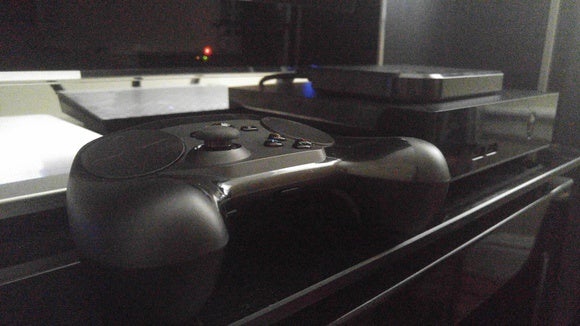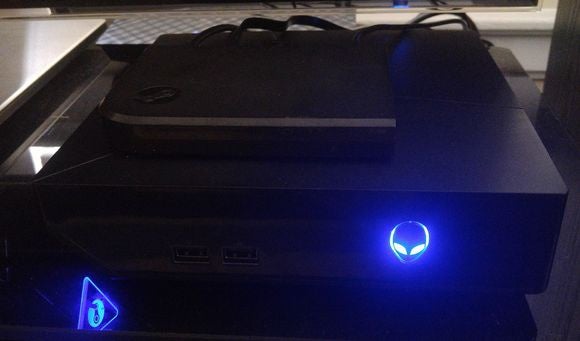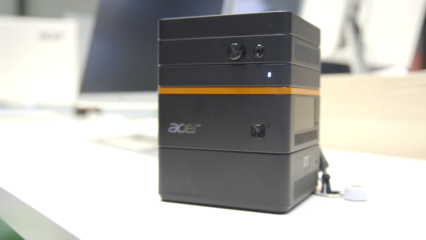Strict Standards: Only variables should be assigned by reference in /home/noahjames7/public_html/modules/mod_flexi_customcode/tmpl/default.php on line 24
Strict Standards: Non-static method modFlexiCustomCode::parsePHPviaFile() should not be called statically in /home/noahjames7/public_html/modules/mod_flexi_customcode/tmpl/default.php on line 54
Strict Standards: Only variables should be assigned by reference in /home/noahjames7/public_html/components/com_grid/GridBuilder.php on line 29
When I abandoned the living room, I did so willingly.
I was a console gamer for many, many years—heck, I still am for certain games—and I know first-hand how comfortable a couch can be. But eventually I was swayed by the PC and all its myriad benefits. A perpetual game library I’d never lose access to or need to repurchase on new machines. More powerful hardware, meaning better resolutions and frame rates and textures. The precision of a mouse and keyboard. Steam sales, glorious Steam sales, which have led me into a dark backlog hole I will likely never dig out of.
A part of me yearned for the couch, though. Not just my butt. There’s something very special about TV gaming—about divorcing yourself from the machine you typically use “for work” and playing in a space solely reserved for entertainment. It’s, at least for me, a different mindset.
And a more social mindset. Playing games on a PC is an inherently isolating experience, insofar as you’re sitting in a chair staring at a relatively small screen. Sure, you might be sitting in the same room as someone or talking to friends through TeamSpeak/Ventrilo, but the computer is a solo experience. It’s meant for your eyes only. The TV is shared.
 Hayden Dingman
Hayden DingmanValve’s Steam Controller, Steam Link, and Alienware’s Steam Machine.
All this is to say that when Valve declared “We’re going to bring PC games to the living room,” I was intrigued. Not that living room PCs were impossible before, but they’ve never been as elegant as Valve’s vision—small, quiet machines built to mesh with your entertainment center, running an operating system that worked without need for a keyboard/mouse or traditional desktop.
Then Steam Machines fell victim to Valve Time and hit a year-long delay and I kind of lost interest. And then Valve announced a $50, streaming-only Steam Link box and I got back on board.
Now? Well I’ve been living in Valve’s living room future for the past week, and I’m loving it—with some major caveats.
The Steam Controller
A lot of discussion has been allocated to Steam Machines and Valve’s Steam Link, and for good reason. Those are the boxes that drive this whole living room environment Valve’s pushing into. They’re the “consoles,” for lack of a better word.
But it’s the Steam Controller that’s actually the most exciting piece of hardware. It’s the key to Valve’s vision: A machine that can play literally every PC game ever made, from Battlefield to Civilization to Cities Skylines to Type Rider to Stanley Parable to Papers, Please to Wasteland 2, all with a single input device. Not just a console, and not just a PC, but both. Without a strong controller it all crumbles apart.

That’s a staggering challenge. And the Steam Controller isn’t a perfect solution. Game design is informed by hardware. It’s why third-person action games are playable with a mouse and keyboard but typically feel more natural on a controller—the input device they were designed around. It’s why MAME cabinets falter when confronted with games like Tapper or Tron that had semi-unique arcade controls.
So Civilization will keep on feeling most natural on a keyboard and mouse, as will Dota 2. The old question of whether we’d see professional Dota 2 players choosing the Steam Controller? I doubt it.
The Steam Controller works, though. It inherits enough from both its predecessors to unlock the full gamut of PC gaming on a single device—and one that’s living-room-appropriate. For whatever reason, we’re seemingly fine as a broad gaming culture with keeping controllers in the living room, but most frown on a wireless keyboard and mouse in the same space. Don’t ask me why.
I talk more about the Steam Controller and why I love it in far greater detail in my Steam Controller hands-on, but suffice it to say it opens up the living room to an entirely new range of experiences. Genres that have typically been confined to the PC, to a monitor, I’ve found myself reevaluating. I look at my computer and then opt to sit in the living room instead. Not all the time, but enough to be notable. My couch has gotten more use this week than it has in the past year.

Point-and-clicks on the couch? Don’t mind if I do.
For comparison, the other day I booted my Xbox One to play Rock Band and realized it had a Mortal Kombat X disc inside—from April. Yeah, I don’t use my actual consoles often, outside of Netflix.
Who’s gonna drive you home?
If we accept that playing games in the living room is a Good Thing, the main question becomes “How do you drive those experiences?” Unfortunately this is where I get bogged down in “But wait!” and “If this, then that” edge cases—not because Valve hasn’t provided choices, but because each choice comes with a significant compromise.
This week I’ve spent many, many hours with two pieces of hardware: Alienware’s Steam Machine and Valve’s own Steam Link. Like the Steam Controller, I’ve taken a more in-depth look at both Alienware and Valve’s hardware, but this article is more a critique of the concept, not the specific execution; an examination of the larger Steam Machine environment versus the Steam Link, a box that’s essentially a conduit that brings Steam in-home streaming to your TV.
Let’s start with Steam Machines. They’re all computers. Computers geared solely toward gaming, but still—these are boxes that run video games. Like other PCs, they come in all different shapes, all different colors. Some are cheap, some are expensive. Some are powerful, some not so much.

Alienware’s is on the less-pricey side.
The important thing is they provide a console-esque experience with better-than-console hardware. You plug them into your TV, you install games, you play.
The downside is, of course, you’re buying a second computer. Whether it’s $450 or $1,450 or (heaven forbid) $5,000, you’re paying a premium price to stick a highly specialized computer into your living room. One that runs SteamOS, Valve’s new Linux-based operating system—meaning even the most massive Steam library will be reduced to a fraction of its size on a Steam Machine, despite the influx of recent releases for Steam for Linux. You’ll need to stream any Windows-only games from your main gaming PC.
Further reading: Steam Machines revealed: Full specs and details for every model
Steam Link is essentially that, but all the time. It’s a streaming-only box, meaning you’re “playing” the game on your main PC, but the image is being routed over your in-home network and displayed on your TV.
I expect most people will go with this option, for a few reasons. But mainly, if we’re being honest, because it’s cheap. A mere $50 gets you access to Steam in your living room, or $100 if you want Steam Link and a Steam Controller.
 Hayden Dingman
Hayden DingmanThis little Steam Link will stream all your PC games to your living room, provided you’ve got the necessary infrastructure.
Plus the power of Steam Link is limited only by the power of your main gaming PC. If your primary rig is running an older Radeon 7850? You’ll see 7850-like performance. If it’s running a ferocious GeForce GTX 980 Ti? The same $50 box will put out 980 Ti performance. When you upgrade, you only need to buy parts for one machine and you’re done. No need to decide whether to pour money into your living room or your primary machine.
But—and this is a big but—Steam Link is entirely dependent upon your in-home network, as I mentioned earlier. Valve recommends that both your computer and Steam Link be on wired connections, and even then you’re likely still going to notice occasional input latency or image compression. Want to (or need to) go wireless? Good luck, and don’t forget to invest in a speedy 802.11ac router.
 Hayden Dingman
Hayden DingmanThe Alienware Steam Machine, with Steam Link atop.
So we’re left with no one-size-fits-all answer. That’s both good and bad: It means we get the freedom of choice, the tailored experience that brought gamers like us to the PC in the first place, but it also means this is not the “console killer” so many seem to want it to be. The Steam Machine and Steam Link are excellent but still overly complicated, still decidedly in the realm of PCs.
I wouldn’t want it any other way. But some people will, and those people are going to head back to their Xbox or PlayStation and be relieved it just works, all the time—and that’s fine too. I’m just happy to get some use out of my couch again.
Bottom line
I am sold on a Steam-powered living room, though. Not so much on the hardware, but on the concept. There are Day One jitters and some bugs to squash and a lot of fairly massive barriers to overcome, many of which I talk about in depth in my Steam Controller, Steam Link, and Alienware Steam Machine hands-ons. But the core idea—bringing the PC into the living room—still holds as much appeal as it did in 2013, when Valve kicked off this whole rigamarole.
Not a PC, not a console, but both. The PC’s invaded my living room, and I think it’s here to stay.



Strict Standards: Only variables should be assigned by reference in /home/noahjames7/public_html/modules/mod_flexi_customcode/tmpl/default.php on line 24
Strict Standards: Non-static method modFlexiCustomCode::parsePHPviaFile() should not be called statically in /home/noahjames7/public_html/modules/mod_flexi_customcode/tmpl/default.php on line 54
Find out more by searching for it!
